1. Sections of a cone: parabola, hyperbola, ellipse
- Books Name
- AMARENDRA PATTANAYAK Mathmatics Book
- Publication
- KRISHNA PUBLICATIONS
- Course
- CBSE Class 11
- Subject
- Mathmatics
Chapter 11
Conic Sections
Sections of a cone: circle, parabola, hyperbola, ellipse:
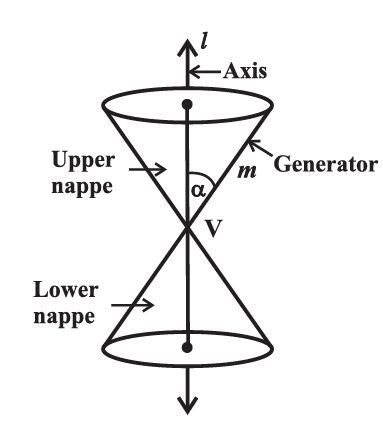
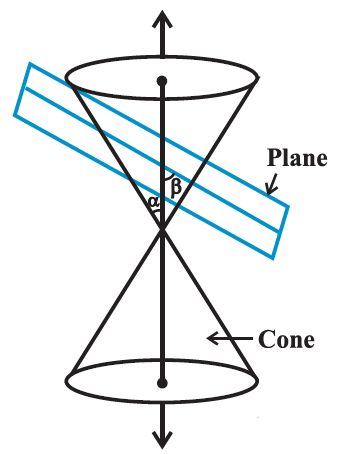
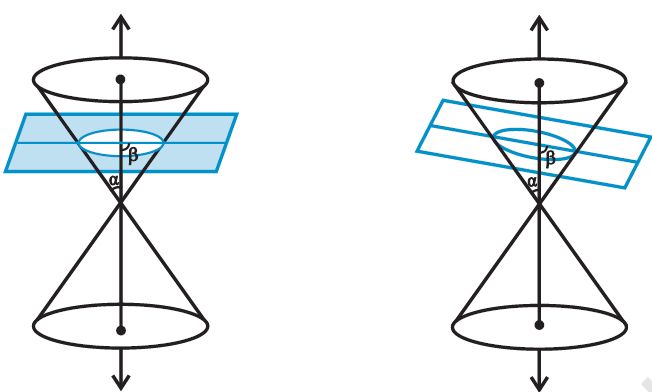
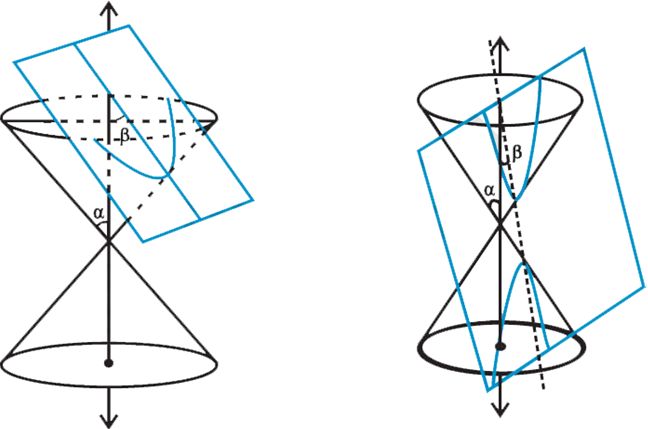
When the plane cuts the nappe (other than the vertex) of the cone, we have the following situations:
(a) When b = 90o, the section is a circle .
(b) When a < b < 90o, the section is an ellipse .
(c) When b = a; the section is a parabola .
(In each of the above three situations, the plane cuts entirely across one nappe of the cone).
(d) When 0 £ b < a; the plane cuts through both the nappes and the curves of intersection is a hyperbola .
Circle: Set of points in a plane equidistant from a fixed point. A circle with radius r and centre (h, k) can be represented as (x – h)2 + (y – k)2 = r2
Parabola: Set of points in a plane that are equidistant from a fixed-line and point. A parabola with a > 0, focus at (a, 0), and directrix x = – a can be represented as y2 = 4ax
In parabola y2 = 4ax, the length of the latus rectum is given by 4a.
Ellipse: The sum of distances of a set of points in a plane from two fixed points is constant. An ellipse with foci on the x-axis can be represented as: 

Hyperbola: The difference of distances of set of points in a plane from two fixed points is constant. The hyperbola with foci on the x-axis can be represented as: ![]()

2. Standard equations, Properties and Application of a circle
- Books Name
- AMARENDRA PATTANAYAK Mathmatics Book
- Publication
- KRISHNA PUBLICATIONS
- Course
- CBSE Class 11
- Subject
- Mathmatics
Standard equations , Properties and Application of a circle
Circle:
Definition: A circle is the set of all points in a plane that are equidistant from a fixed
point in the plane.
The fixed point is called the centre of the circle and the distance from the centre
to a point on the circle is called the radius of the circle.
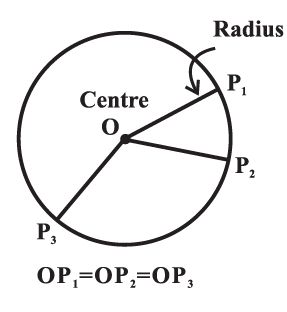
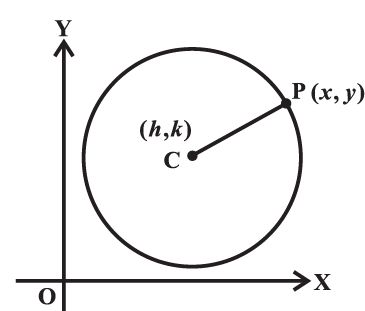
Given C (h, k) be the centre and r the radius of circle. Let P(x, y) be any point on
the circle . Then, by the definition, | CP | = r . By the distance formula,
we have
(x-h)2 + (y-k)2= r2
This is the required equation of the circle with centre at (h,k) and radius r .
General form of Equation of a Circle
The general equation of any type of circle is represented by:
x2 + y2 + 2gx + 2fy + c = 0, for all values of g, f and c.
Adding g2 + f2 on both sides of the equation gives,
x2 + 2gx + g2+ y2 + 2fy + f2= g2 + f2 − c ………………(1)
Since, (x+g)2 = x2+ 2gx + g2 and (y+f)2 =y2 + 2fy + f2 substituting the values in equation (1), we have
(x+g)2+ (y+f)2 = g2 + f2−c …………….(2)
Comparing (2) with (x−h)2 + (y−k)2 = a2, where (h, k) is the center and ‘a’ is the radius of the circle.
h=−g, k=−f
a2 = g2+ f2−c
Therefore,
x2 + y2 + 2gx + 2fy + c = 0, represents the circle with centre (−g,−f) and radius equal to a2 = g2 + f2− c.
- If g2 + f2 > c, then the radius of the circle is real.
- If g2 + f2 = c, then the radius of the circle is zero which tells us that the circle is a point that coincides with the center. Such a type of circle is called a point circle
- g2 + f2 <c, then the radius of the circle become imaginary. Therefore, it is a circle having a real center and imaginary radius.
N.B.: Standard Equation of Circle: ![]()
centre (0, 0) and Radius (r)
Equation of circle in centre radius form: ![]()
Centre (h, k), Radius = r
Equation of circle in General form: ![]()
Where (–g, –f ) centre
r2 = g2 + f2 – c .
![]()
Equation of circle with points P(x1, y1) and Q(x2, y2) as extremities of diameter is
(x – x1) (x – x2) + (y – y1) (y – y2) = 0
Equation of circle through three non-collinear points P(x1, y1), Q(x2, y2) and R(x3, y3) is

Area of circle = πr2
Perimeter = 2πr, where r is the radius.
Example: Find an equation of the circle with centre at (0,0) and radius r.
Solution :Here h = k = 0. Therefore, the equation of the circle is x2 + y2 = r2
Example: Find the equation of the circle with centre (–3, 2) and radius 4.
Solution: Here h = –3, k = 2 and r = 4. Therefore, the equation of the required circle is
(x + 3) 2 + (y –2)2 = 16
Example : Find the centre and the radius of the circle x2 + y2 + 8x + 10y – 8 = 0
Solution : The given equation is
(x2 + 8x) + (y22+ 10y) = 8
Now, completing the squares within the parenthesis, we get
(x2+ 8x + 16) + (y2 + 10y + 25) = 8 + 16 + 25
i.e. (x + 4)2 + (y + 5)2 = 49
i.e. {x – (– 4)} 2+ {y – (–5)} 2 = 72
Therefore, the given circle has centre at (– 4, –5) and radius 7.
Example : Find the equation of the circle which passes through the points (2, – 2), and (3, 4) and whose centre lies on the line x + y = 2.
Solution: Let the equation of the circle be (x – h)2 + (y – k)2 = r2.
Given that the circle passes through the points (2, –2) and (3, 4).
Thus,
(2 – h)2 + (–2 – k)2 = r2….(1)
and (3 – h)2 + (4 – k)2 = r2….(2)
Also, given that the centre lies on the line x + y = 2.
⇒ h + k = 2 ….(3)
Solving the equations (1), (2) and (3), we get
h = 0.7, k = 1.3 and r2 = 12.58
Hence, the equation of the required circle is
(x – 0.7)2 + (y – 1.3)2 = 12.58
3. Standard equations, Properties and Application of a parabola
- Books Name
- AMARENDRA PATTANAYAK Mathmatics Book
- Publication
- KRISHNA PUBLICATIONS
- Course
- CBSE Class 11
- Subject
- Mathmatics
Standard equations , Properties and Application of a parabola
Parabola:
Definition: A parabola is the set of all points in a plane that are equidistant from a fixed line
and a fixed point (not on the line) in the plane.
The fixed line is called the directrix of the parabola and the fixed point F is called the focus 11. (‘Para’ means ‘for’ and ‘bola’ means ‘throwing’, i.e., the shape described when you throw a ball in the air).
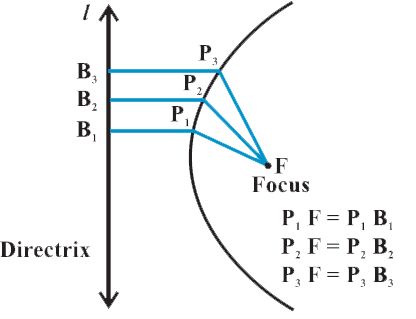
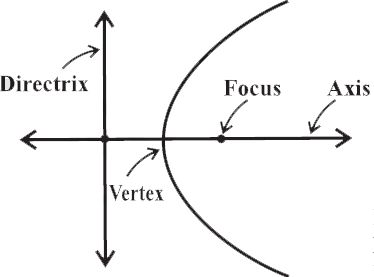
A line through the focus and perpendicular to the directrix is called the axis of the parabola.
The point of intersection of parabola with the axis is called the vertex of the parabola.
Standard equations of parabola
The equation of a parabola is simplest if the vertex is at the origin and the axis of symmetry is along the x-axis or y-axis. The four possible such orientations of parabola.
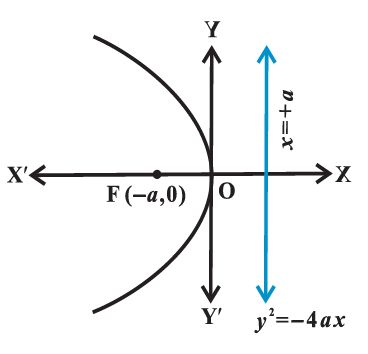
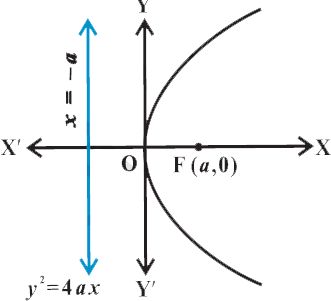
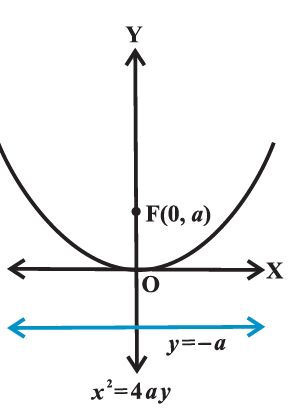
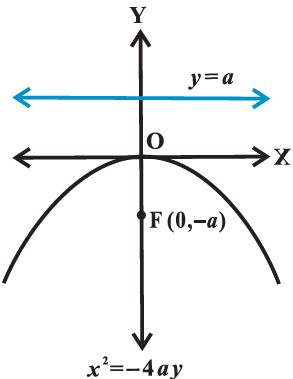
Let P(x, y) be any point on the parabola such that
PF = PB, ... (1)
where PB is perpendicular to l. The coordinates of B are (– a, y). By the distance
formula, we have
(PF) 2 = (x – a)2 + y2 and (PB) 2 = (x + a) 2
Since PF = PB, we have
(x – a) 2 + y2 = (x + a) 2
or x2 – 2ax + a2 + y2 = x2 + 2ax + a2
or y2 = 4ax ( a > 0). is Standard equation of Parabola.
Latus rectum
Definition : Latus rectum of a parabola is a line segment perpendicular to the axis of
the parabola, through the focus and whose end points lie on the parabola .
To find the Length of the latus rectum of the parabola y2 = 4ax .
By the definition of the parabola, AF = AC.
But AC = FM = 2a
Hence AF = 2a.
And since the parabola is symmetric with respect to x-axis AF = FB and so
AB = Length of the latus rectum = 4a.
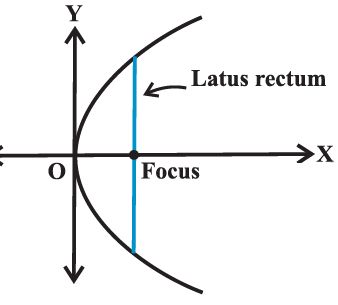
Example : Find the coordinates of the focus, axis, the equation of the directrix and latus rectum of the parabola y2 = 8x.
Solution The given equation involves y2, so the axis of symmetry is along the x-axis.
The coefficient of x is positive so the parabola opens to the right. Comparing with the given equation y2 = 4ax, we find that a = 2.
Thus, the focus of the parabola is (2, 0) and the equation of the directrix of the parabola is
x = – 2 .
Length of the latus rectum is 4a = 4 × 2 = 8.
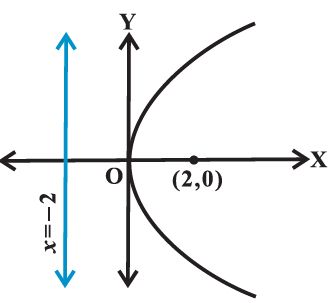
Properties:
- Parabola is symmetric with respect to the axis of the parabola.If the equation
has a y2 term, then the axis of symmetry is along the x-axis and if the
equation has an x2 term, then the axis of symmetry is along the y-axis.
2. When the axis of symmetry is along the x-axis the parabola opens to the
(a) right if the coefficient of x is positive,
(b) left if the coefficient of x is negative.
3. When the axis of symmetry is along the y-axis the parabola opens
(c) upwards if the coefficient of y is positive.
(d) downwards if the coefficient of y is negative
Example: Find the equation of the parabola with focus (2,0) and directrix x = – 2.
Solution :Since the focus (2,0) lies on the x-axis, the x-axis itself is the axis of the
parabola. Hence the equation of the parabola is of the form either
y2 = 4ax
- y2 = – 4ax. Since the directrix is x = – 2 and the focus is (2,0), the parabola
is to be of the form y2 = 4ax with a = 2.
Hence the required equation is
y2 = 4(2)x = 8x
Example: Find the equation of the parabola with vertex at (0, 0) and focus at (0, 2).
Solution: Since the vertex is at (0,0) and the focus is at (0,2) which lies on y-axis, the
y-axis is the axis of the parabola. Therefore, equation of the parabola is of the form
x2 = 4ay. thus, we have
x2 = 4(2)y, i.e., x2= 8y.
4. Standard equations, Properties and Application of a ellipse
- Books Name
- AMARENDRA PATTANAYAK Mathmatics Book
- Publication
- KRISHNA PUBLICATIONS
- Course
- CBSE Class 11
- Subject
- Mathmatics
Standard equations , Properties and Application of a ellipse
Ellipse
Definition: An ellipse is the set of all points in a plane, the sum of whose distances from two fixed points in the plane is a constant. The two fixed points are called the foci (plural of ‘focus’) of the ellipse.
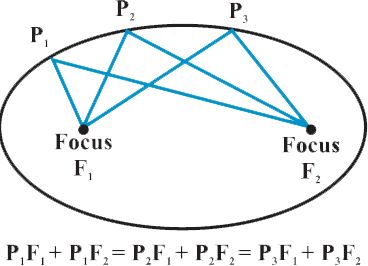
The mid point of the line segment joining the foci is called the centre of the ellipse. The line segment through the foci of the ellipse is called the major axis and the line segment through the centre and perpendicular to the major axis is called the minor axis. The end points of the major axis are called the vertices of the ellipse
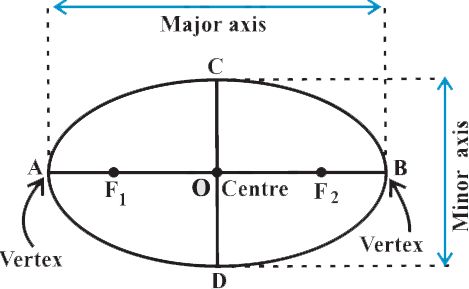
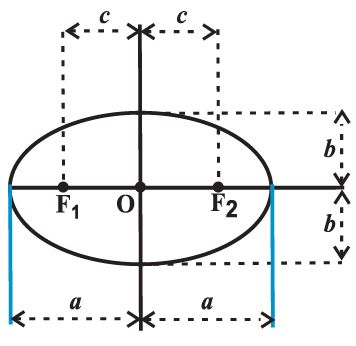
We denote the length of the major axis by 2a, the length of the minor axis by 2b and the distance between the foci by 2c. Thus, the length of the semi major axis is a and semi-minor axis is b
Relationship between semi-major axis, semi-minor axis and the distance of the focus from the centre of the ellipse:
Sum of the distances of the point P to the foci is F1 P + F2P = F1O + OP + F2P
(Since, F1P = F1O + OP)
= c + a + a – c = 2a
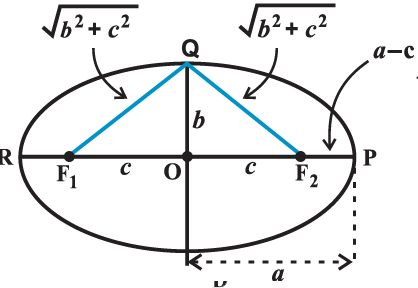
a2 = b2 + c2
Special cases of an ellipse In the equation c2 = a2 – b2 obtained above, if we keep a fixed and vary c from 0 to a, the resulting ellipses will vary in shape.
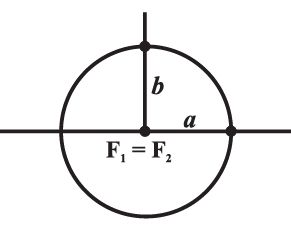
Case (i) When c = 0, both foci merge together with the centre of the ellipse and a2 = b2, i.e., a = b, and so the ellipse becomes circle . Thus, circle is a special case of an ellipse.
Case (ii) When c = a, then b = 0. The ellipse reduces to the line segment F1F2 joining the two foci.

Eccentricity
Definition: The eccentricity of an ellipse is the ratio of the distances from the centre of the ellipse to one of the foci and to one of the vertices of the ellipse (eccentricity is denoted by e) i.e., e= c/a
Standard equations of an ellipse The equation of an ellipse is simplest if the centre of the ellipse is at the origin and the foci are on the x-axis or y-axis.
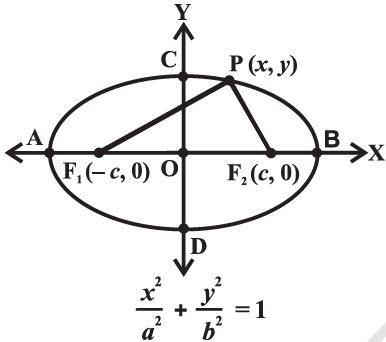
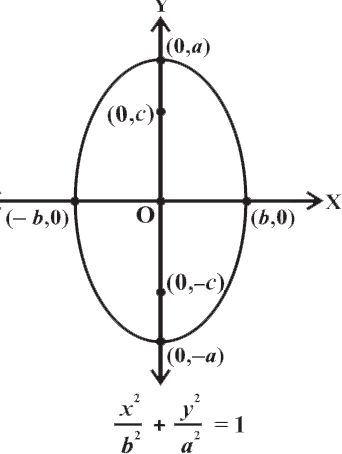
Let F1 and F2 be the foci and O be the midpoint of the line segment F1F2. Let O be the origin and the line from O through F2 be the positive x-axis and that through F1as the negative x-axis.
Let, the line through O perpendicular to the x-axis be the y-axis. Let the coordinates of F1 be (– c, 0) and F2 be (c, 0) .
Let P(x, y) be any point on the ellipse such that the sum of the distances from P to the two foci be 2a
so given PF1 + PF2 = 2a.
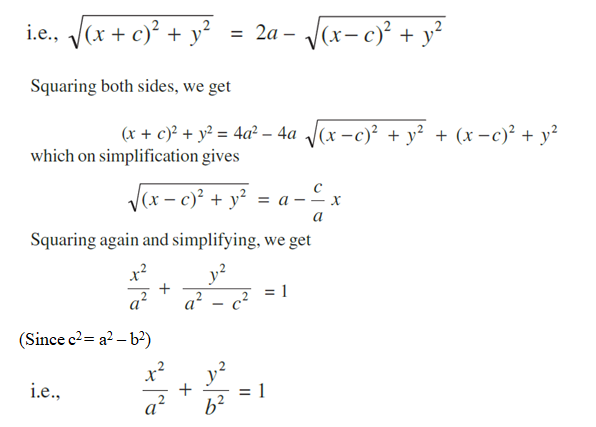
Hence any point on the ellipse satisfies satisfies

the geometric condition and so P(x, y) lies on the ellipse.
Therefore, the ellipse lies between the lines x = – a and x = a and touches these lines.
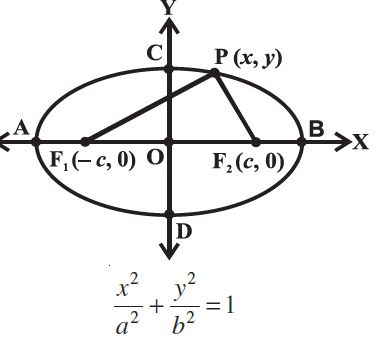
Similarly, the ellipse lies between the lines y = – b and y = b and touches these lines.
Similarly, we can derive the equation of the ellipse.

These two equations are known as standard equations of the ellipses.
Properties:
1. Ellipse is symmetric with respect to both the coordinate axes since if (x, y) is a point on the ellipse, then (– x, y), (x, –y) and (– x, –y) are also points on the ellipse.
2. The foci always lie on the major axis. The major axis can be determined by finding the intercepts on the axes of symmetry. That is, major axis is along the x-axis if the coefficient of x2 has the larger denominator and it is along the y-axis if the coefficient of y2 has the larger denominator.
Latus rectum
Definition: Latus rectum of an ellipse is a line segment perpendicular to the major axis through any of the foci and whose end points lie on the ellipse.
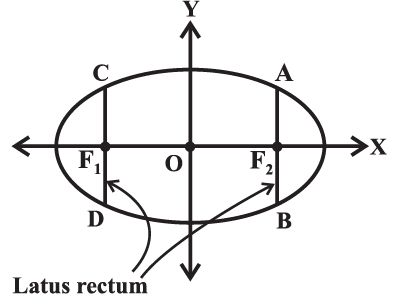
Let the length of AF2 be l. Then the coordinates of A are (c, l ),
i.e., (ae, l )
Since A lies on the ellipse

we have

- l2 = b2 (1 – e2) but e2=c2/a2 = 1- (b2/a2)
Therefore, l2 = b4/a2
- l = b2/a
Since the ellipse is symmetric with respect to y-axis (of course, it is symmetric w.r.t. both the coordinate axes), AF2 = F2B and so length of the latus rectum is 2l =2b2/a
Example: Find the coordinates of the foci, the vertices, the length of major axis, the minor axis, the eccentricity and the latus rectum of the ellipse

Solution Since denominator of x2/25 is larger than the denominator of y2/9 , the major
axis is along the x-axis.
a = 5 and b = 3. Also
c =√(a2 – b2)
=√(25 – 9)
=4
Therefore, the coordinates of the foci are (– 4,0) and (4,0), vertices are (– 5, 0) and
(5, 0). Length of the major axis is 10 units length of the minor axis 2b is 6 units and the
eccentricity is 4/5. and latus rectum is 2b2/a = 18 /5
5. Standard equations, Properties and Application of a hyperbola
- Books Name
- AMARENDRA PATTANAYAK Mathmatics Book
- Publication
- KRISHNA PUBLICATIONS
- Course
- CBSE Class 11
- Subject
- Mathmatics
Standard equations , Properties and Application of a hyperbola
Hyperbola
Definition : A hyperbola is the set of all points in a plane, the difference of whose distances from two fixed points in the plane is a constant.
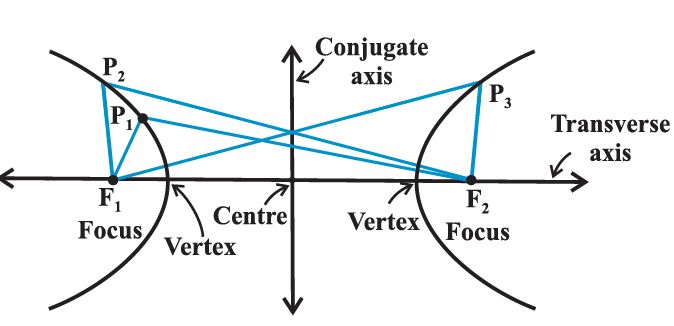
The term “difference” that is used in the definition means the distance to the farther point minus the distance to the closer point. The two fixed points are called the foci of the hyperbola. The mid-point of the line segment joining the foci is called the centre of the hyperbola. The line through the foci is called the transverse axis and the line through the centre and perpendicular to the transverse axis is called the conjugate axis. The points at which the hyperbola intersects the transverse axis are called the vertices of the hyperbola.
The distance between the two foci by 2c, the distance between two vertices (the length of the transverse axis) by 2a.
b= √(c2- a2)
2b is the length of the conjugate axis
we have
BF1 – BF2 = AF2 – AF1 (by the definition of the hyperbola)
BA +AF1– BF2 = AB + BF2– AF1
i.e., AF1 = BF2
So that, BF1 – BF2 = BA + AF1– BF2 = BA = 2a
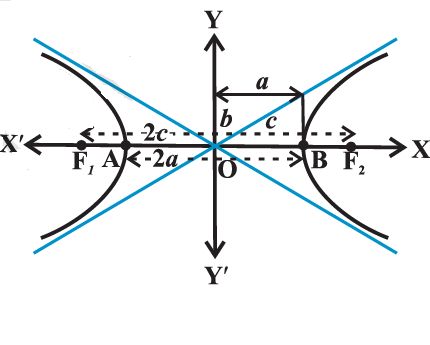
Eccentricity
Definition : similarly, an ellipse, the ratio e = c / a is called the eccentricity of the
hyperbola. Since c ³a, the eccentricity is never less than one.
In terms of the eccentricity, the foci are at a distance of ae from the centre.
Standard equation of Hyperbola: The equation of a hyperbola is simplest if
the centre of the hyperbola is at the origin and the foci are on the x-axis or y-axis. The
two such possible orientations.
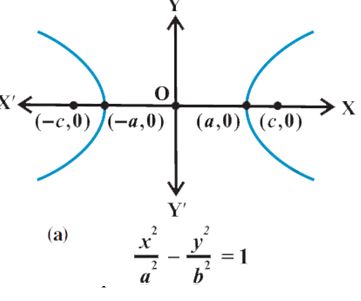
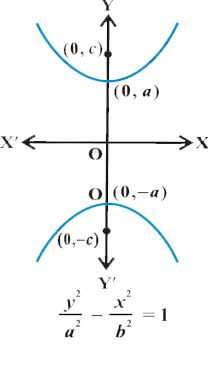
Let F1 and F2 be the foci and O be the mid-point of the line segment F1F2. Let O
be the origin and the line through O through F2 be the positive x-axis and
that through F1 as the negative x-axis.
Let P(x, y) be any point on the hyperbola such that the difference of the distances from P to the farther point minus the closer point be 2a.
So given, PF1 – PF2 = 2a
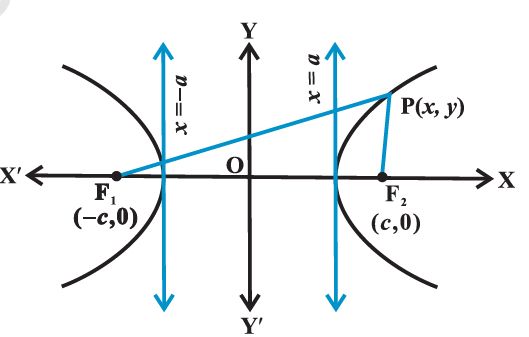
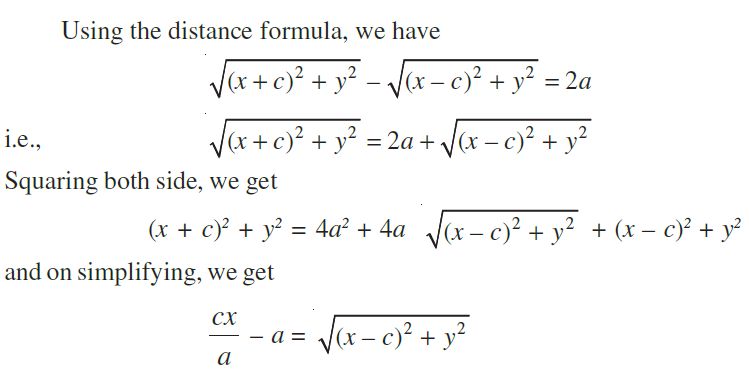
On squaring again and further simplifying, we get
 (Since c2 – a2 = b2)
(Since c2 – a2 = b2)
Or

Note.: A hyperbola in which a = b is called an equilateral hyperbola.
Therefore, no portion of the curve lies between the
lines x = + a and x = – a, (i.e. no real intercept on the conjugate axis).
Similarly, we can derive the equation of the hyperbola.

These two equations are known as the standard equations of hyperbolas.
Properties:
- Hyperbola is symmetric with respect to both the axes, since if (x, y) is a point on the hyperbola, then (– x, y), (x, – y) and (– x, – y) are also points on the hyperbola.
- The foci are always on the transverse axis. It is the positive term whose denominator gives the transverse axis.
![]() has transverse axis along x-axis of length 6.
has transverse axis along x-axis of length 6.
![]() has transverse axis along y-axis of length 10.
has transverse axis along y-axis of length 10.
Latus rectum:
Definition Latus rectum of hyperbola is a line segment perpendicular to the transverse axis through any of the foci and whose end points lie on the hyperbola.
The length of the latus rectum in hyperbola is 2b2/a
Example Find the equation of the hyperbola where foci are (0, ±12) and the length of the latus rectum is 36.
Solution Since foci are (0, ±12), it follows that c = 12.
Length of the latus rectum = 2b2/a = 36
or b2 = 18a
Therefore c2 = a2 + b2; gives
144 = a2 + 18a
i.e., a2 + 18a – 144 = 0,
So a = – 24, 6.
Since a cannot be negative, we take a = 6 and so b2 = 108.
Therefore, the equation of the required hyperbola is
Or, 
i.e., 3y2 – x2 = 108
Question :1 An ellipse passes through the foci of the hyperbola, 9x2 −4y2 =36 and its major and minor axes lie along the transverse and conjugate axes of the hyperbola respectively. If the product of eccentricities of the two conics is 1/2. Find the equation of ellipse.
Solution:
Equation of hyperbola is 9x2 −4y2 =36 or x2/4 − y2/9 = 1
(Here a < b)
Focus = (0, ± be)
Eccentricity = e = √(1+4/9) = √13/3
So, Foci of hyperbola: (0, ±√13)
Standard equation of the ellipse, x2/a2 + y2/b2 = 1 …(i)
Eccentricity = e’ = √(1-a2/b2) …(ii)
ee’ = 1/2 (given)
Using eccentricity value of hyperbola, e’ = 1/2 x 3/√13 = 3/2√13
(ii) e’2 = (1-a2/b2)
9/52 = (1-a2/b2)
Find the value of b2 form (i) using focii 13/b2 = 1 => b2 = 13
9/52 = (1-a2/13)
9/4 = 13 – a2
a2 = 43/4
Now equation of ellipse is 4x2/43 + y2/13 = 1
Question 2: The locus of a point P(α, β) moving under the condition that the line y = αx + β is a tangent to the hyperbola x2/a2 – y2/b2 = 1 is
(a) an ellipse
(b) a circle
(c) a hyperbola
(d) a parabola
Answer: (c)
Solution:
Tangent to the hyperbola x2/a2 – y2/b2 = 1 is y = mx ± √(a2m2 – b2)
Given that y = αx + β is the tangent of hyperbola.
m = α and a2m2 – b2 = β2
Therefore, a2 α 2 – b2 = β2
Locus is a2 x 2 – y2 = b2 , which is parabola.

 KRISHNA PUBLICATIONS
KRISHNA PUBLICATIONS
